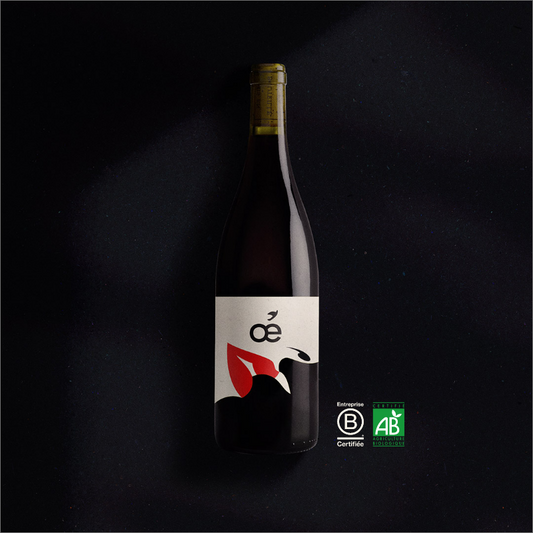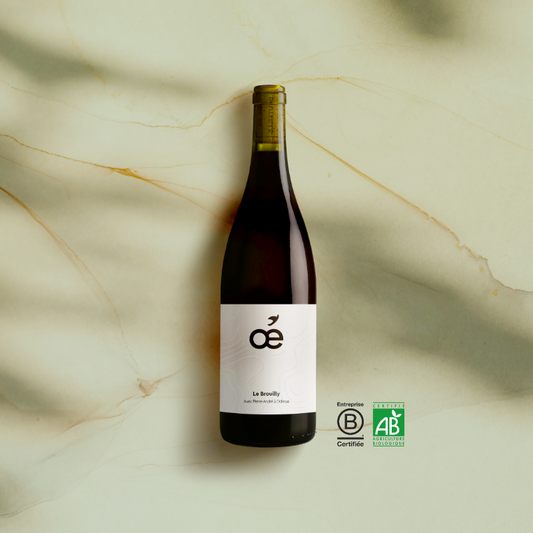As some of you may have seen, the Oé Program for Biodiversity has been given a boost thanks to two select partners. For several months, we have been working with EcoFarms and MiiMOSA to support Oé winegrowers in going far beyond organic. Today, we invite you to meet the EcoFarms team to learn more about their role in the Oé Program for biodiversity. We're on board, let's go!
Would you like to know more about the Oé Program for Biodiversity? We tell you everything here!

Can you tell us about EcoFarms and its history?
Kevin : “ Emma and I both carried out a first entrepreneurial project in the agricultural sector - respectively the financing and the insurance of transition projects towards sustainable agriculture. We quickly realized that the ecosystem lacked a first building block necessary for the emergence of new, innovative and coherent services like ours. A solid basis that would make it possible to redefine a more sustainable agricultural development model: the assessment of the sustainability of agricultural holdings .
We decided to create in April 2020 EcoFarms , an independent company of the Social and Solidarity Economy. It is the premier farm sustainability rating agency for farmers and their partners.
This is the first step in their progress approach. It is also a valuation tool that allows them to communicate transparently to their stakeholders on their strengths and areas for improvement.
For cooperatives, buyers and funders, evaluation is a common language, simple but not simplistic. They rely on it to manage their network of producers (sourcing, monitoring, accelerating the improvement of results by offering them appropriate services, etc.) and communicating on their various media (internal, social networks, products, etc.) on the results obtained at the individual or network level. EcoFarms offers decision-makers the assurance of doing things well and proof of their commitment to sustainable agriculture. To sum up: EcoFarms is the accelerator of sustainable agriculture.”
How does the process work?
“As the famous scientist Kelvin said, “You can't manage without measuring and only what gets measured gets done. Measurement is the antidote to ambiguity, it forces clarity on vague concepts and it forces action.
As with any consistent progress approach (“measure, learn, act”), we wanted to improve the sustainability and impact of farms, and start by establishing a reliable and comprehensive evaluation methodology . A methodology that responds to the uncertainty and growing complexity facing agriculture. The ready-made solutions of yesterday, when it was first necessary to produce more to feed the world, have now become obsolete. For many months, we analyzed existing studies, publications and benchmarks, interviewed dozens of experts, scientists, farmers, technicians, to come up with a first robust version of our evaluation benchmark.
It includes more than 250 indicators, grouped into 21 themes (biodiversity, impact on climate, soils, farmer's quality of life, governance, economic health, transmissibility, etc.), themselves divided according to the 3 dimensions of the sustainable development: Agro-Environmental, Socio-Territorial and Economic .
Today, our work is challenged by our scientific committee and independent experts, and consists in developing this methodology to stick as closely as possible to scientific advances and societal expectations.
This methodology is at the heart of the diagnosis offered to farmers and their partners. The measurements and analyzes made allow us to provide farmers with relevant suggestions for improvement within their farms and to structure their progress approach.
We then provide online access to the EcoFarms Toolbox, in which we list hundreds of solutions (services, products, practical sheets, independent advisers, etc.) so that they can act concretely and independently on the areas of progress that we have identified together. We can measure the progress made in the following years. The results of the diagnosis also allow the winegrowers and Oé to value their commitments and reward the efforts made.”

What are the stages of your support for Oé winegrowers?
“In concrete terms, the process of evaluating a farm like that of the Oé winegrowers is simple and takes place in 3 stages for the farmer:
- Respond to a questionnaire and provide various supporting documents that certify the data provided.
- Discuss during a first meeting with one or more analysts from our teams, then a second on his farm to validate certain control points and get to know the farmer, his desires and his vision for the years to come so that the results provided are as relevant as possible to its context.
- After the expert analysis of the data collected, he is sent an evaluation report with his results and he is given access to the member space on which he can find the other members of the community, the toolbox and his communication kit. so that he can enhance his approach. We then organize a telephone conversation with him to answer any questions he may have and together set the progress objectives for the years to come.
The diagnostic results are valid for three years. We organize an exchange with the farmer every year to follow the progress made on the farm and readjust the objectives for the coming year. Throughout this time, the farmer retains access to the various tools (member area, toolbox and communication kit including a dedicated page on the EcoFarms Map - which will soon be unveiled! -) in order to continue his approach.
Do you have any figures for us on the farmers and winegrowers who are committed to the planet with you?
“The seven Oé winegrowers assessed have a sustainability index at least 12 points higher than the average for comparable farms . This figure illustrates well the work carried out for many years by the latter on certain issues of sustainable agriculture, in particular thanks to their approaches which promote biodiversity and to human-sized farms, anchored in their territory.
Many figures can illustrate these commitments:
- 338.85ha of developed biodiversity areas: farms contribute to landscape complexity by promoting habitats for fauna and flora . These contribute to the preservation of biodiversity and guarantee adaptation to climate change, the completion of the water cycle, or the storage of carbon, nitrogen, etc. They represent 88% of the total area covered by the Oé winegrowers' holdings .
- The soils have a coverage rate of more than 60% (ie they are covered by plants on average 60% of the time) favoring the structure and biodiversity of the soil and making it possible, for example, to prevent its erosion.
- An average Phytosanitary Treatment Frequency Index of 9.81 (ranging from 3.48 to 18.16), against an average TFI of 20.1 nationally. This figure illustrates that Oé farms only use phytosanitary products sparingly, thus improving their impact on issues such as biodiversity, air and water pollution or even their operating costs.
- From a greenhouse gas balance point of view , the farms emit a total of approximately 436 teqCO2/year. They also store 436 teqCO2/year overall, and therefore achieve neutrality at the group level. (436.5 tonnes CO2 equivalent/year compared to 435.9 teqCO2/year). The "CO2 equivalent tonne" is a unit of measurement where all emissions are reduced to "CO2 equivalent" (example: 1 molecule of methane emitted by cows = 4 molecules of CO2).
- Only 15% wastage of production at the field level against more than 30% on average at the national level
The challenge will be to take these results forward in the coming years in order to improve their positive contribution to the world!”
How do you see agriculture in 20 years?
“It's not easy to give a simple answer to this question! Who could have imagined in February 2020, the tormented 18 months that we were going to experience next? On the side of French farmers, very few are those who, on April 4, could have imagined the episode of historic frost which was to hit them hard two days later. Ditto for our Belgian and German neighbors who experienced dramatic floods this summer, or for our Canadian and Spanish friends who experienced extreme temperatures (50° and 45° respectively). And this, even if the origins of these phenomena are well known and even predicted by scientists: collapse of biodiversity for the first and climate change for the others (at +1.1°C! We cannot imagine the consequences at 1.5° or even 2°C...).
Agriculture, being at the heart of human activity since it meets a vital need, its development is subject to many factors and hazards. To try my hand at the exercise, I must therefore make some strong assumptions. By taking into account growing environmental pressures (climate change, depletion of resources and non-renewable energies, collapse of biodiversity, etc.), societal expectations and growing regulatory constraints, and the demand for agricultural production which will have to increase drastically ( + 70% in 30 years according to the FAO ), agriculture will be, in a suffered or voluntary way - all the stakes are there! -, oriented towards a more sustainable model.
It will be more autonomous and robust in the face of hazards (diversification of production, stronger cooperation between actors, etc.). Finally, it will be recognized for the ecosystem services it provides through its strong contribution to environmental (carbon storage, regeneration of ecosystems, etc.), social (job creation, contribution to regional food resilience, etc.) objectives. ) and economic (decent remuneration, redistribution of resources, etc.) that we have set ourselves ( Sustainable Development Goals - UN ).
Furthermore, it should not be forgotten that agriculture is made up of very different contexts (geographical, social, economic, political, etc.) and production systems. Everyone will therefore experience more or less radical changes!
To take a simple example that speaks to all of us here, there is a good chance that many of our French wines no longer resemble those we know today. Either because we had to relocate production to more favorable regions, or because the alcohol content will no longer be the same.
Despite this depicted horizon, which may seem gloomy at first sight, I am convinced that our activities, by being transformed, will refocus us on projects and tasks that are more essential and therefore more fulfilling for each individual. As the Oé winegrowers do, respecting and taking care of the living (and the good living!) that surrounds them.”





